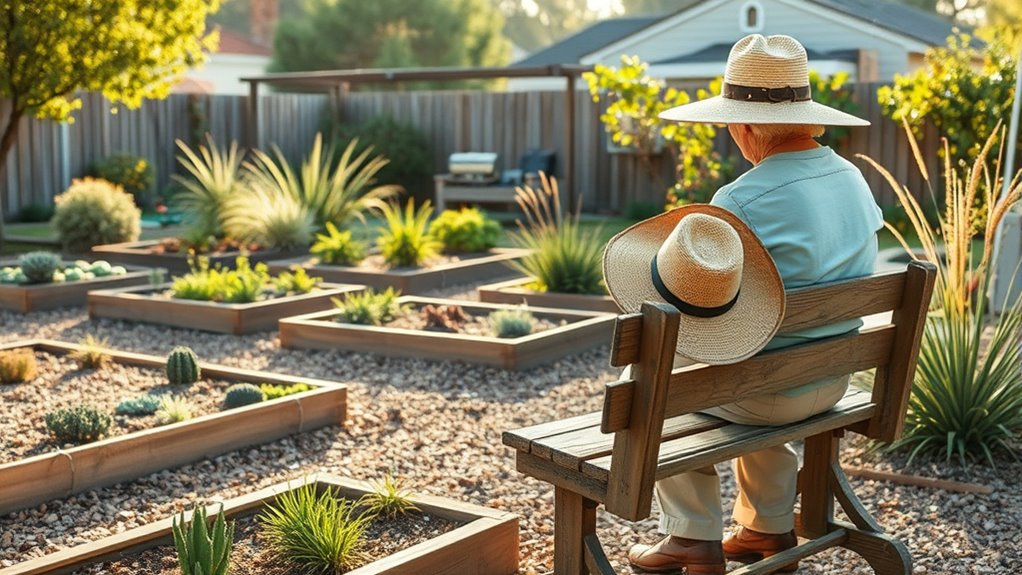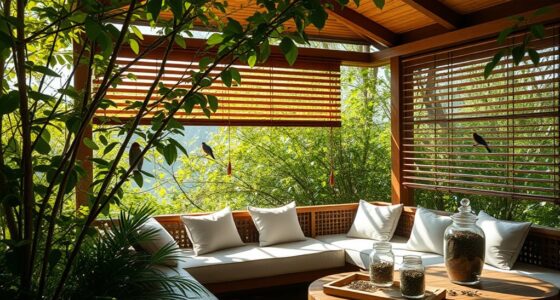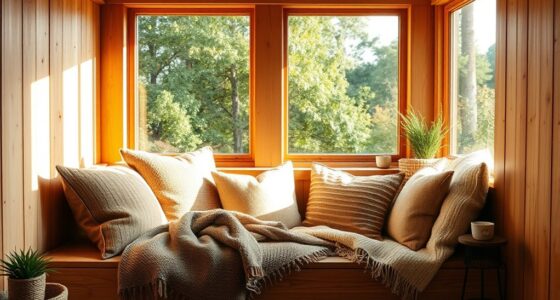To enjoy a low-maintenance yard, choose native plants that thrive in your climate and require less water and care. Use ground covers, mulching, and raised beds to minimize weeding and physical effort. Incorporate automatic watering systems like drip irrigation and keep tools simple and lightweight. Regular, brief inspections help catch pests early, while natural deterrents and beneficial insects keep pests at bay. Keep your garden organized and plan ahead to enjoy a beautiful yard with less work—discover more tips as you continue.
Key Takeaways
- Use native, drought-tolerant plants grouped by similar watering needs to reduce maintenance.
- Incorporate mulch and ground covers to minimize weeds and conserve moisture.
- Install raised beds, containers, and automated watering systems for easier access and less effort.
- Select pest-resistant plants and introduce natural deterrents like marigolds to reduce pest control chores.
- Schedule brief, regular garden visits for early detection of issues and to keep the yard healthy with minimal effort.

Many people want a beautiful garden without spending hours on upkeep, and low-maintenance gardening makes that possible. When you focus on smart garden design, you create a space that’s both attractive and easy to care for. Start by selecting plants that are naturally hardy and suited to your local climate. Native plants tend to require less water, fertilizer, and attention, which simplifies your routine. Incorporating ground covers and low-growing shrubs can also reduce the need for frequent weeding and mulching, saving you time and effort.
A well-thought-out garden design emphasizes simplicity and functionality. Group plants with similar watering and sunlight needs to avoid over- or under-watering, which can lead to unnecessary maintenance or plant health issues. Use raised beds or containers for easy access, making tasks like planting, watering, and pruning less strenuous. Mulching around your plants helps retain moisture, suppress weeds, and reduce pest entry, so you spend less time battling pests and weeds. When designing your garden, consider pathways that allow you to move easily through the space without stepping on delicate beds, minimizing damage and the need for repairs. Additionally, choosing Vetted low-maintenance tools can streamline your gardening tasks and reduce physical strain.
Effective pest control is crucial in a low-maintenance garden because pests can quickly turn a beautiful yard into a problematic one. Opt for plants that are resistant to common pests, reducing the need for chemical interventions. You can also introduce natural pest deterrents like marigolds or garlic around your garden to keep unwanted visitors at bay. Regularly inspecting your plants helps catch issues early, preventing pests from spreading and causing extensive damage. If pests do appear, choose targeted treatments that don’t require frequent reapplication, such as organic insecticidal soaps or beneficial insects like ladybugs. These approaches keep pest problems manageable without the fuss of constant spraying or chemical use. Furthermore, utilizing knowledge from Kia Tuning can inspire creative ways to customize your garden for better pest resistance or easier maintenance.
Furthermore, staying informed about AI and automation advancements can help you discover new tools and techniques that make garden maintenance even easier. For example, integrating crochet techniques for locs into your gardening tools can inspire innovative ways to organize and store your equipment for quick access. To keep your garden in top shape with minimal effort, invest in tools that make maintenance easier. Self-watering systems, drip irrigation, and lightweight tools can make watering and pruning less taxing. Scheduling routine but brief visits to your garden ensures you can catch problems early—whether it’s pests, weeds, or dead branches—before they become bigger issues. With thoughtful garden design and proactive pest control, you’ll enjoy a vibrant, healthy yard that looks great without demanding too much of your time. The key is to plan ahead, choose the right plants, and keep an eye out for trouble spots, so gardening remains a pleasure rather than a chore.
Frequently Asked Questions
What Are the Best Tools for Seniors With Limited Mobility?
When choosing tools for limited mobility, you want ergonomic gardening tools that reduce strain and make tasks easier. Lightweight watering cans help you water plants without fatigue, and long-handled tools allow you to reach without bending. These tools keep you active while minimizing effort and discomfort. With the right ergonomic gardening tools and lightweight watering cans, you can enjoy gardening safely and comfortably, even with mobility challenges.
How Can I Prevent Pests Without Using Chemicals?
To prevent pests without chemicals, try using natural repellents like garlic spray or neem oil, which deter bugs safely. You can also practice companion planting by pairing plants that repel pests with your garden crops, such as marigolds near tomatoes. These methods create a natural barrier, reducing pests effectively while keeping your yard safe and easy to care for. Plus, they’re simple to implement and maintain.
What Are Drought-Tolerant Plants Suitable for My Area?
Imagine transforming your yard into a vibrant xeriscape with native grasses like blue grama. These drought-tolerant plants thrive with minimal water, making them perfect for your area. By incorporating native grasses into your xeriscape design, you create a sustainable, low-maintenance landscape that conserves water and reduces upkeep. This approach not only beautifies your yard but also supports local ecosystems, giving you a beautiful, eco-friendly outdoor space.
How Often Should I Water Low-Maintenance Gardens?
You should water your garden based on its specific needs and your local climate. Establish a consistent watering schedule, typically once or twice a week, ensuring deep garden hydration. Check the soil moisture regularly; if it feels dry a few inches below the surface, it’s time to water. Avoid overwatering, which can harm plants. Adjust your schedule during hot, dry spells to keep your low-maintenance garden healthy and thriving.
Can I Grow Vegetables in a Small, Low-Maintenance Yard?
Your small yard is a treasure trove waiting to be explored! Yes, you can grow vegetables there with container gardening and vertical planting. These methods maximize limited space, making gardening easier and more manageable. You can grow tomatoes, peppers, or herbs in pots or vertical planters, which are perfect for small areas. With a little effort, you’ll enjoy fresh produce and a vibrant garden without feeling overwhelmed.
Conclusion
By choosing easy-care plants and smart landscaping, you can enjoy a beautiful yard without the extra effort. Did you know that nearly 60% of seniors spend less than an hour a week on gardening? With these low-maintenance tips, you’ll have more time to relax and enjoy your outdoor space. Gardening should be fun, not exhausting—so make it simple, enjoyable, and tailored to your needs. Happy gardening!









